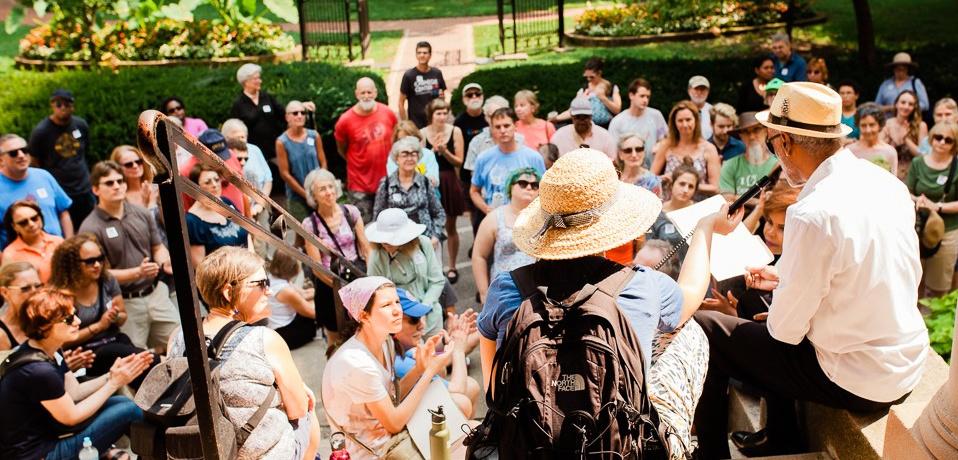Jay Pitter: Lecture & Workshop

photo / provided
- Bio: Jay Pitter
- LECTURE: Place, Joy, and Justice 9:30–11:15 a.m. EST
- WORKSHOP: Engaging Black People and Power 1:30–5:30 p.m. EST
- Q&A with Jay Pitter
Bio: Jay Pitter
Jay Pitter, MES, is an award-winning placemaker whose practice mitigates growing divides in cities across North America. She spearheads institutional city-building projects specializing in public space design and policy, forgotten densities, mobility equity, gender-responsive design, inclusive public engagement, and healing fraught sites. What distinguishes Jay is her multidisciplinary approach, located at the nexus of urban design and social equity, which translates community insights and aspirations into the built environment. Ms. Pitter has used this urgent, evidence-based expertise to shape numerous projects in over 25 cities including working with Westbank to preserve intangible cultural heritage and expand engagement during the Honest Ed's redevelopment project in Toronto, leading the (RE)IMAGINING Cheapside Confederate monument placemaking process in Lexington and applying a gender-responsive design lens to the redevelopment of Granville Bridge in Vancouver. She has developed an equitable planning certificate course with the University of Detroit's Mercy School of Architecture, a women in city-building course with the University of Toronto, and an Engaging Black People and Power course spurred by the murder of George Floyd. Ms. Pitter has also presented at MIT, Harvard, and Princeton universities, among many others. She was recently the John Bousfield Distinguished Visitor in Planning at the University of Toronto and shortlisted for the Margolese National Design for Living Prize. Her forthcoming books, Black Public Joy and Where We Live, will be published by McClelland & Stewart, Penguin Random House Canada.
LECTURE: Place, Joy, and Justice 9:30–11:15 a.m. EST
As cities head into another year, still reckoning with the COVID-19 pandemic and the fallout from civil rights uprisings, it is imperative to bring to the foreground the urban policies and social attitudes perpetuating spatialized anti-Blackness. This lecture takes us back to the auction block, uncovers the invisible force of discriminatory urban policy, interrogates status-quo planning approaches, explores the political meanings inscribed in beautiful Black skin and unapologetically tethers Black peoples' joy to justice.
WORKSHOP: Engaging Black People and Power 1:30–5:30 p.m. EST
Cheryl Harris, legal scholar, writes that enslaved individuals of African descent became "propertized human life," governed under both private property and constitutional laws. Like all forms of property, these commodified human beings "could be transferred, assigned, inherited, or posted as collateral." This state-sanctioned violation created the foundation for legal and quasi-legal urban policy that has perpetuated the continued exploitation of Black labour, restriction of Black bodies, and denial of dignified space for Black lives to flourish. Taking into account spatialized anti-Blackness, the Engaging Black People and Power intensive half-day academic workshop examines how the invisible force of discriminatory urban policy, status quo land-use planning approaches, and social attitudes continue to threaten a Black sense of place while acknowledging implications for other equity-deserving groups.
This workshop is derived from an award-winning graduate urban policy course—spurred by the public execution of George Floyd—developed and taught by Jay Pitter at York University's Faculty of Environmental and Urban Change. Like the course, this workshop also draws on the seminal scholarship of W.E.B. Du Bois and honors the ancestral place-based knowledge of Ms. Pitter's Black elders who reside in cities across North America. Following an introductory lecture by Ms. Pitter, students will complete an in-workshop, small-group assignment incorporating theoretical texts and a dozen case studies featuring the insights of esteemed Black urbanists such as Mitchell Silver, the former commissioner of the New York City Parks Department; Orlando Bailey, the Emmy award-winning place-based storyteller; and Anthony Taylor, a leading Minneapolis-based cycling equity advocate.
Students will leave with an annotated bibliography and personal reflection worksheet to transform workshop learning toward action.
If you would like to attend this event, please register here.
The event is co-sponsored by the Office of the Vice Provost for Academic Affairs, Office of Faculty Development and Diversity, AAP Dean's Office, Department of City and Regional Planning, Susan Christopherson Center for Community Planning, Clarence S. Stein Institute, and Baker Program in Real Estate.
Q&A with Jay Pitter
As a placemaking practitioner with a reputation for being on the frontlines of urban equity issues, why did you create an academic course in response to George Floyd's murder and civil uprising?
All forms of hate are perpetuated by miseducation and ignorance. While struggling to process the tragic losses of George Floyd, Breonna Taylor, Ahmaud Arbery, Regis Korchinski-Paquet, and so many others, I felt atypically helpless. During that moment of despair, I received an invitation from York University's new Faculty of Environmental and Urban Change to teach an urban policy course. I quickly seized the opportunity to create a studio-style course, Engaging Black People and Power, situating these and other tragedies within a larger historical and urban policy paradigm to unpack the long-standing issue of spatialized anti-Blackness. I feel strongly about ensuring that theory connects with community and practice, so I invited other Black urbanists to share their immense professional insights with my students. Teaching a course during a civil rights uprising is frankly a privileged act, but it was a tangible contribution that I could make at the time. Moreover, expanding and contesting the urbanism canon is critical for making change in cities.
Where did the course name, Engaging Black People and Power, originate?
I'm influenced by the work of W.E.B. Du Bois, a foremost sociologist, activist, and the first African-American to earn a doctorate at Harvard University. I'm specifically intrigued by the work he led in the late 1890s in Philadelphia's 7th ward to address neighborhood blight and related issues such as poverty, high crime rates, and drug use. He even moved into the neighborhood and went door-to-door, which I immensely respect. This work was framed as addressing the "Negro Problem," which is a term that he and his contemporaries used to describe structural anti-Blackness at that time. I have incredible respect for Du Bois and appreciate the use of the term during that era. However, I'm concerned that the term reinforces contemporary ideas pertaining to Black people and communities being a problem that the state needs to solve. It's also clear that many individuals perceive Black people as a problem, especially when we publicly resist racism. This is both ironic and heartbreaking given the grace, kindness, and patience we've exhibited throughout centuries of unspeakable spatialized anti-Blackness. It was important for me to underscore that Black people and our communities are not the problem. The auction block is the problem, red-lining is the problem, police profiling is the problem, amenity inequity is the problem, and so forth. The only way to rectify these and other problems is to begin to respectfully engage with Black people and power.
In one sentence describe what you want Cornell students and faculty to take away from your Engaging Black People and Power workshop?
I'd like workshop participants to leave more informed, emotionally invested, and emboldened to contribute to change.
This past year at Cornell, we've had a series of talks and workshops working through anti-Black racism and anti-Asian racism. But it's been hard to get beyond the conceptualization of racism as a bilateral relationship between White and Black or White and Asian. How do you think the diversity of our identities can help give us move towards solidarity rather than division?
There is value in racialized groups having separate conversations with white people to address their distinct histories of colonization, stereotypes, and numerous forms of marginalization. However, when we also integrate a place-based lens that considers shared impacts of colonialization experienced across racialized groups, our migration and immigration patterns, and discriminatory urban policies that have created racialized margins, we are able to co-locate our struggles in a meaningful manner. This creates the opportunity for us to honestly acknowledge discrimination within racialized communities—most notably anti-Blackness and anti-Indigeneity—to heal wounds caused by competing for colonial rewards and to foster greater solidarity. When racialized and other equity-deserving groups decentre whiteness long enough to learn about and honor each other others' oppression, activate our collective power, and take appropriate responsibility for our contribution to harm, we then disrupt legacies of colonialism, capitalism, and patriarchy. This creates unity among racialized people while contributing to justice and belonging for all people.
Indigenous scholar Heather Dorries writes that coverage of violence towards Indigenous peoples, even from a "progressive" bent, has normalized narratives of Indigenous groups as broken and violated. She argues that "the problem of racism must be framed in a way that emphasizes the flourishing of Indigenous life rather than focusing on Indigenous death." Does this resonate with you in the protests and media coverage of Black Lives Matter?
I respect how Dr. Dorries has specifically applied this idea to resisting settler colonial violence through an Indigenous feminist planning lens and I agree that her ideas are applicable to other racialized groups. When exploring this concept within the context of Black Lives Matter, I am also concerned about the ways that death narratives pathologize. In my own practice and research, I critique the ways non-racialized groups promote racialized narratives focused on death and despair to reinforce their superiority, advance political agendas and sell trauma. This critique definitely applies to much of the media coverage of the Black Lives Matter protests. However, the colonial project is literally designed to extinguish lives through structural racism enacted across educational, health, urbanism, and other sectors. So, in the case of protestors and others resisting threats to their lives, the critique must remain squarely on the structural colonial forces perpetuating ongoing threats.
In addition to power, you talk a lot about public joy in your practice. How did you incorporate joy in a course like this and your broader placemaking during a time of immense turmoil?
Unencumbered, soulful joy has always been rooted across Black cultures and our justice-based movements. You may recall numerous videos of Black protestors dancing and singing in the street amid grave danger and Black healthcare workers dancing in the streets after excruciating days of treating COVID-19 patients. This has always been our way and I leaned into joy because, in addition to teaching emotionally and intellectually challenging course material, I was navigating considerable personal grief. During COVID-19, I lost a friend and her late-term unborn baby girl. Three days later, a young man with whom I had collaborated in the southern U.S. drowned. Then, another friend suddenly died amid the creation of the course resource. Finally, my partner was the victim of an anti-Asian knife attack less than a block from the entrance to our loft. So, I sent students uplifting notes that had nothing to do with grades or performance, swapped humorous YouTube videos, and went on virtual walks. During that time, I also made it a point to celebrate small things that brought me joy on a daily basis and remained connected to friends whose presence evoked a sense of light in my life.







